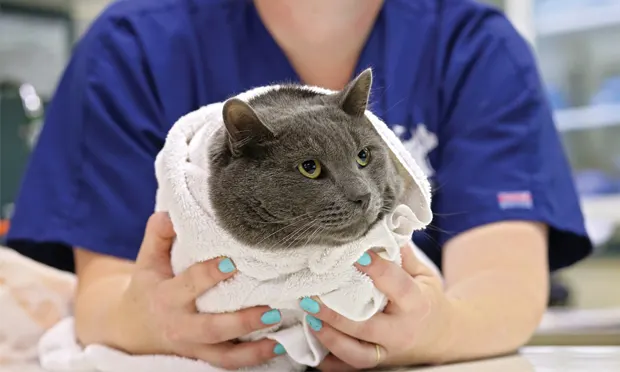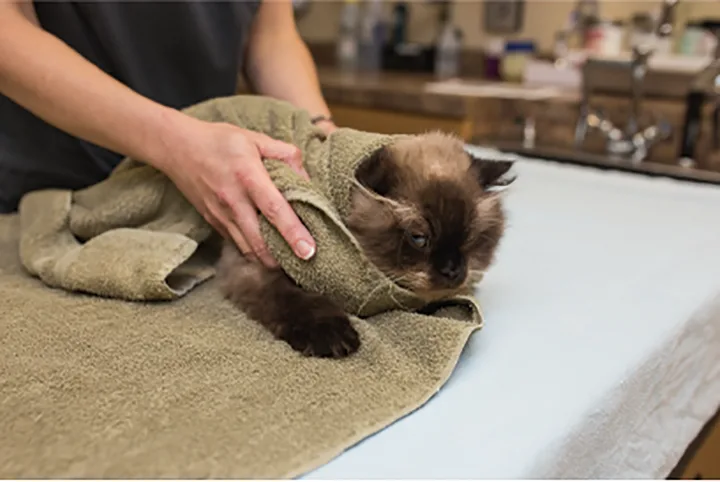Techniques for Towel Restraint of Cats
Liza Wysong Rudolph, BAS, CVT, VTS (CP-CF, SAIM), East Coast Veterinary Education, Aberdeen, Maryland

Not many cats enjoy a visit to the veterinarian, and really, who can blame them? They are trapped in a carrier, placed in a moving vehicle, and whisked into a strange-smelling building with other animals. Too often, they are unceremoniously removed from their carrier and poked and prodded by unfamiliar humans. It is also understandable that owners are hesitant to bring their cats for wellness visits.
Veterinary professionals must strive to promote a positive, feline-friendly visit that includes appropriate handling methods.
Minimize the Stress
Cats are generally less accepting of restraint compared with dogs; they commonly receive less socialization and, as a prey species, may feel vulnerable when restrained, leading to a panicked reaction. Veterinary professionals’ gut reaction to a struggling cat is often to hold tighter or pin the patient down, which typically worsens the situation. Additionally, cats are agile and can be adept at escape. During the struggle for freedom, an agitated cat is likely to bite and/or scratch the handler.1
This negative experience reinforces to feline patients that the veterinary visit is something to be feared, and it is imperative, therefore, to minimize their stress. The handling method should be tailored to the individual patient; if the initial method is unsuccessful, the technique should be changed before the patient becomes agitated, because the patient’s tolerance for restraint will be greatly diminished, chemical restraint may be less effective, and higher doses may be required to override the circulating catecholamines. If intense manual restraint occurs during handling, the veterinarian may choose to utilize chemical restraint in the patient’s best interest.1-4
Chemical Restraint Options
The veterinarian should consider many variables (eg, medical procedure; patient’s age, health, medical history) before suggesting a sedation protocol.2,4 Clients can orally administer alprazolam (0.125-0.25 mg) before the visit; a test dose at home on a nonstressful day is recommended.2,5 For simple procedures that require mild restraint (eg, venipuncture) or if the examination is limited because of the patient’s painful area, transmucosal buprenorphine (0.02 mg/kg) can be administered by the veterinarian in the examination room.2,6 Many drug combinations are available for mild restraint to full sedation, but in the author’s experience at her practice, midazolam and butorphanol (both 0.2 mg/kg SC or IM) provide sufficient sedation for cats without pain; dexmedetomidine (0.001-0.02 mg/kg IM) and/or ketamine (1-5 mg/kg IM) can be added for full sedation.2,4 It is important to note that only veterinarians can administer any of these drugs.
Choose the Right Technique
Although scruffing is often the go-to technique for handling feline patients, behaviorists now consider it controversial because of its variable effects (eg, some cats may experience a calming effect, others become anxious and resistant to restraint).1,3 Scruffing is typically recommended only for the former group.1,3 Each patient must be evaluated to determine its ideal restraint technique.1,3
Proper restraint will result in a calmer patient, reduced struggling and likelihood of escape, and some injury protection for the handler.
Cats should be positioned so they feel safe and calm and thus more likely to cooperate. Various towel restraint techniques can help achieve this goal and can be tailored to each patient and procedure. Proper restraint will result in a calmer patient, reduced struggling and likelihood of escape, and some injury protection for the handler.1-3 Towels can be sprayed beforehand with a synthetic facial pheromone (Feliway) to help further calm the patient. If the patient continues to struggle, use a different technique and consider chemical restraint.1-3
Many towel restraint techniques can be used for cats, including blanket wraps; burrito, half-burrito, or reverse burrito wraps; scarf wraps; back wraps; and chin rest wraps. The varied techniques allow accessibility to different areas of the patient for different procedures. Some wraps, such as the burrito styles, are fairly intuitive, whereas others, such as the scarf wrap, are more complicated. All towel restraint methods require practice and patience.1 (See the Scarf Wrap and the Modified Scarf Wrap.)
The Scarf Wrap: A Step-by-Step Guide

Step 1A
Wrap the towel over the patient.
Modified Scarf Wrap: A Step-by-Step Guide

Step 1
Wrap the first side the same way as for a regular scarf wrap.
Involve the Client
Clients can help their cat identify towels as familiar—not feared—objects by integrating them into the home where positive associations can be made (eg, near where the cat eats, sleeps, or plays; areas where petting and owner interactions occur).1,3,7 Similar techniques can be used to familiarize the cat with a carrier; clients should place the carrier in an accessible common area several days before a planned veterinary visit. A synthetic facial pheromone spray or diffuser may help reduce patient stress during the introduction of these new objects.1,3,7
Conclusion
Not every technique will work well with every patient. Cats have individual personalities and veterinary professionals must be willing to adapt. Implementing feline-friendly handling techniques will promote a positive experience for feline patients and their owners, increased safety for veterinary team members, and increased frequency of feline wellness visits.
This article originally appeared in the September 2015 issue of Veterinary Team Brief.